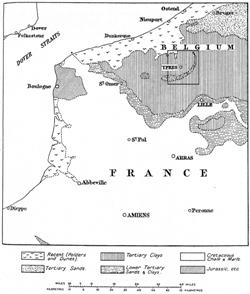
TERRAINS
Geologically, the BEF occupied land of three terrains. The first was a coastal zone of contemporary sand dunes, and Quaternary sediments reclaimed (as ‘polders’) from the sea. The second consisted of the Flanders Plain, mostly underlain by a bedrock sequence of alternating (mostly Lower Eocene) mudrocks and weakly cemented sandstones (similar to the London and Hampshire Basins in England). The third comprised the plateaux of Picardy and Artois, underlain by bedrock of Upper Cretaceous Chalk (similar also to that of southern England).
The scale and intensity of largely static warfare on the Western Front stimulated many technical innovations. The German Army was quicker than the British to make use of geological expertise, beginning in 1914. By 1916 it had developed a military geological organisation as such, with 29 teams of geologists, one for each section of the ‘military mapping and survey’ service as then constituted. The British Army made slower use of geologists, as two particular problems became evident.
Picture: Near-contemporary geological sketch map of Belgium and northern France centred on the British-occupied region of the Western Front in World War I: area of Figure 7 outlined
WATER SUPPLY
The BEF expanded progressively from one to five armies. At its peak in 1916 it comprised some 1.5 million men and 500,000 horses/mules (mostly to transport stores forward from railheads, rather than as mounts for cavalry!). As numbers of men and animals increased, water supply became a problem. Each man/animal was calculated to require 10 gallons (45 litres) of water per day to meet all requirements. However, near the front line both surface and ground waters were vulnerable to pollution by munitions, ordure, dead bodies of men and animals, while pipelines were vulnerable to damage. Water from civilian wells was usually insufficient to support the high concentration of troops.
The problem was solved by innovations that included mobile rigs, bought from the USA, to drill deep boreholes; air lift pumps raised water quickly and in quantity from these depths; Well Boring Sections in the Royal Engineers (one per army) were formed to operate the new drilling equipment; and a geologist was appointed to serve as a staff officer at BEF General Headquarters to guide drilling for potable water. His name was Lieutenant (later Captain) W B R King.